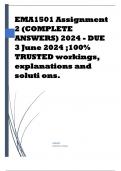EMA1501 Assignment
2 (COMPLETE
ANSWERS) 2024 - DUE
3 June 2024 ;100%
TRUSTED workings,
explanations and
soluti ons.
ADMIN
[COMPANY NAME]
, QUESTION 1 Mathematics does not happen in a vacuum but is part of an
integrated approach to the child’s development. Mathematics should be
embedded and integrated in all the activities the children engage in
throughout the day, such as feeding time, playtime, rest/sleep time, routine
morning, midday and evening activities, etc. 1.1. Define Emergent
Mathematics. (4) 1.2. Think of a story or stories you were told as a child. Think
about any part of the story that had mathematical themes, concepts or ideas
and in a paragraph of between 8 to 10 lines or 100 words, relate the
memories and mathematical concepts you learned from the story. (10) 1.3.
Play is often referred to as a child’s work, and that it is very important for
learning. In a paragraph of 5 to 6 lines, examine the relationship between play
and emergent mathematics. (6) Downloaded by Corona Virus ()
lOMoARcPSD| 6 1.4. There are theories that are implicated in the teaching
and learning of emergent mathematics in the early years. Create a three-
column table where you discuss how teaching and learning takes place
according to Piaget, Vygotsky and Bruner. (30) (50)
1.1. Emergent Mathematics refers to the natural development of mathematical understanding
and skills in young children through their everyday experiences and interactions with the
environment. It emphasizes the importance of integrating mathematical concepts into various
activities rather than formal instruction. This approach recognizes that children begin to grasp
mathematical ideas through exploration, experimentation, and problem-solving within their daily
routines and play.
1.2. As a child, I vividly remember the story of "The Three Little Pigs." Beyond its entertainment
value, the story inherently conveyed mathematical concepts. For instance, the pigs' construction
of houses involved decision-making based on the comparative durability of materials—straw,
sticks, or bricks. This introduced the idea of quantitative reasoning and problem-solving.
Additionally, the narrative highlighted spatial concepts as the wolf attempted to navigate and
overcome the physical barriers created by the pigs' structures, offering a subtle lesson in
geometry and spatial relations.





